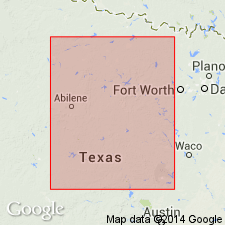
- Usage in publication:
-
- Jacksboro formation
- Modifications:
-
- Original reference
- Dominant lithology:
-
- Limestone
- Sandstone
- Shale
- AAPG geologic province:
-
- Bend arch
- Fort Worth syncline
Summary:
Pg. 133-145. Jacksboro formation in Cisco division. Approximately 60 feet of limestones and sandstone with a little shale. Contains fossiliferous CAMPOPHYLLUM bed that is everywhere recognized. Top member is Jacksboro limestone, which plays out in the sandstone hills southwest of Jacksboro, [Jack County], and appears again in section north of Finis [now a ghost town, http://www.texasescapes.com/], on Mineral Wells-Graham road, easternmost Young County. Underlies Bunger formation and overlies Eastland formation. [Age is Pennsylvanian.]
[GNC remark (ca. 1936, US geologic names lexicon, USGS Bull. 896, p. 1034): †Jacksboro formation of Cisco group (Jack and Young Cos., central northern TX) abandoned. According to F.B. Plummer and R.C. Moore, 1922 (Univ. Texas Bull., no. 2132, p. 138 and table 2), Jacksboro limestone member of Graham formation is characterized by CAMPOPHYLLUM TORQUIUM, but CAMPOPHYLLUM bed of Drake is the much younger Gunsight limestone member of Graham formation.]
Source: US geologic names lexicons (USGS Bull. 896, p. 1034; USGS Bull. 1200, p. 1900).
For more information, please contact Nancy Stamm, Geologic Names Committee Secretary.
Asterisk (*) indicates published by U.S. Geological Survey authors.
"No current usage" (†) implies that a name has been abandoned or has fallen into disuse. Former usage and, if known, replacement name given in parentheses ( ).
Slash (/) indicates name conflicts with nomenclatural guidelines (CSN, 1933; ACSN, 1961, 1970; NACSN, 1983, 2005, 2021). May be explained within brackets ([ ]).

